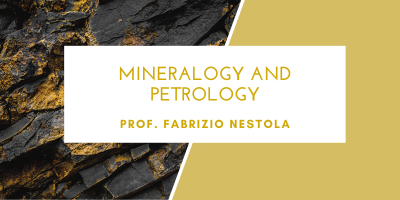Mineralogy and Petrology

Period: Second semester
Course unit contents:
The first part of the course consists of the following contents:
- The internal structure of the Earth and its most abundant chemical elements; mineral definition; basics of crystallography; isomorphism and polymorphism; physical properties of minerals: habit, density, hardness, fracture and cleavage, brightness, color, reactivity with acids, magnetism, radioactivity.
- Systematic mineralogy: chemical composition, symmetry, physical properties, formation environments of the most common terrestrial minerals including: SiO2 polymorphs, plagioclase, K-feldspar polymorphs, feldspathoids, phyllosilicates, pyroxenes, amphiboles, olivine polymorphs, garnets, epidote, staurolite, Al2SiO5 polymorphs, serpentine polymorphs, main carbonates, phosphates and sulphates, main oxides, hydroxides and sulphides.
- Instrumental techniques of mineralogical analysis: X-ray diffraction; X-ray fluorescence spectrometry (XRF); electron microprobe and scanning electron microscopy (SEM); microRaman spectroscopy.
- Laboratory: macroscopic identification of minerals.
The second part of the course consists of the following contents:
- Classification, structures and textures of intrusive, effusive and metamorphic rocks; melting of crust and mantle and genesis of basic, intermediate and acid magmas; principles and processes of crystallization and magmatic differentiation; solubility of volatile species in magmas; relations between magmatism and geodynamic environments; factors controlling metamorphism; metamorphic reactions; the metamorphic facies; relations between metamorphism and geodynamic environments.
Planned learning activities and teaching methods: The course is organized in lectures. During the lessons, powerpoint files with images, diagrams and videos and laboratories for the identification of minerals and rocks through the analysis of macroscopic samples and optical microscope analysis are used. The teaching is interactive, with questions and presentation of case studies, to promote discussion and critical thinking among students.
In addition to contacting the course instructor, students with disabilities, Specific Learning Disorders (SLD), Special Educational Needs (SEN), and other health conditions can reach out to the Student Services Office - Inclusion Unit to receive more information about opportunities to access teaching with specific support and tools.
